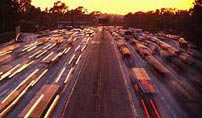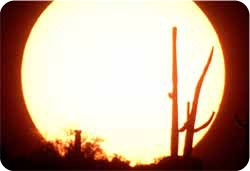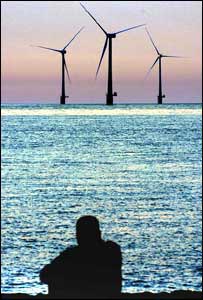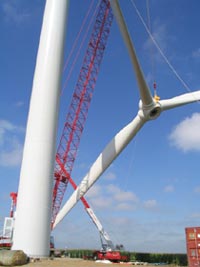| (insert your NIE or newspaper logo here) | Weekly Online LessonOnline Lesson ArchiveGrade Level: 5-7
|
The Wind & Sun: Powerful Alternatives
 In
recent years, scientists, governments, and concerned citizens have been
researching and discussing what seems to be an abnormally rapid rise in
global temperatures.
In
recent years, scientists, governments, and concerned citizens have been
researching and discussing what seems to be an abnormally rapid rise in
global temperatures.
This trend, many believe, has been caused by the burning of fossil fuels. This combustion process is used to provide electricity and run our cars. Unfortunately, it also releases toxic gases, like carbon dioxide. Some experts refer to them as "greenhouse gases" and believe they are what's causing our planet to heat up, referred to as the "greenhouse effect."
In response to the evidence, which includes studies of melting glaciers, rising water levels, and shifts in weather patterns - 160 nations met in Kyoto, Japan in 1997 to discuss a plan of action in order to curb this trend.
Called the Kyoto Protocol, as of 2005, the plan is backed by 141 nations. It does not include the world's top polluter, the United States.
By signing the agreement, the industrial nations are committed to cutting greenhouse gas emissions. Over the next seven years, the goal is to lower the pollution to 5.2% below 1990 levels.
Enforcement of the plan began Wednesday, February 16, 2005.
 In
hammering out the details for achieving the plan's goals, these nations
face a mix of challenges. Ultimately, the steps to success will include
promoting energy conservation, along with reducing fossil fuel use and
developing alternative energy power.
In
hammering out the details for achieving the plan's goals, these nations
face a mix of challenges. Ultimately, the steps to success will include
promoting energy conservation, along with reducing fossil fuel use and
developing alternative energy power.
Already, many nations, including the U.S., are producing some amount of electricity tapping into two of our most promising alternative energy sources: the wind and the Sun.
Americans get most of their electricity by burning fossil fuels, like coal and oil. In recent years, however, several wind farms have been built along coastlines and on prairies, while more and more solar panels are being installed by homeowners and businesses.
Even though the U.S. has not committed itself to the Kyoto agreement, developing these alternative sources will be vital to our future. It will help to ensure electricity and make our environment healthier.
So for this week's lesson, you'll find out how the power of the wind and Sun are being used to generate electricity.
Here Comes the Sun
 Let's
begin with looking at the Sun - at Project Sol in Arizona
to be exact.
Let's
begin with looking at the Sun - at Project Sol in Arizona
to be exact.
Begin by exploring Power for the Future.
What proportion of each primary resource do we use to generate electricity in the U.S.? Why is energy conservation so important to our future?
List the ways in which people, includign yourself, use electricity every day. Also, find out how and where your local electricity is produced.
Now, discover how Energy from the Sun is generated. What two basic elements are involved? About how much of this energy actually reaches the Earth?
Next, learn about how Energy Changes from one form to another in your own body. What are some More Forms of Energy? How do you create potential energy for your body, and in what ways do you expend energy? What are some ways in which you use Electrical Energy every day?
Of course, none of that would be possible, without getting some Energy for Life on this planet. Why is Photosynthesis important? What kinds of Energy for People are most commonly used? How does the combustion, or burning, of some resources compare with the use of Renewable Energy Sources?
From here, take a closer look at Electrical Energy, which will help explain what Electric Charges are and some Electricity Basics.
Is copper a conductor and an insulator? How does that relate to its resistance?
 Try
mapping out the Electricity
Circuits throughout your school or home, including the appliances
or devices that need electricity to be used.
Try
mapping out the Electricity
Circuits throughout your school or home, including the appliances
or devices that need electricity to be used.
What's the difference between DC and AC? What's the importance of having a transformer?
Now, let's journey Inside a Photovoltaic (PV) System. How exactly do electrons flow from the Sun, through the silicon atoms, and form into a current?
Next, review Arizona's Solar Data to compare the effects of Insolation, Temperature, Weather, and Panel Tilt. How does geographical location affect these factors?
Blowing in the Wind
 Now,
let's travel to Denmark - the global leader in wind power development
- and explore Wind with Miller.
Now,
let's travel to Denmark - the global leader in wind power development
- and explore Wind with Miller.
Start by taking Miller's Crash Course.
During the course, you will Assemble a Wind Turbine, Name the Parts of a turbine, see How a Wind Turbine Generates Electricity, and get an inside look at The Tower of the Wind Turbine.
You'll also discover How Wind is Created.
How does the height of the tower compare to buildings or other tall structures near your school or home? What factors probably influence where experts decide to place a wind turbine?
Back at the home page again, let's take Miller's advice and try How Does it Work?
Here, you'll learn more about each of the turbine's parts and how they work. (Do some of the related activities, if possible):
 In
looking at how the parts of the turbine work individually and together,
can you think of any other types of machines that are constructed or
operate in a similar way?
In
looking at how the parts of the turbine work individually and together,
can you think of any other types of machines that are constructed or
operate in a similar way?
Aside from the structure itself, obviously how Wind is generated and other factors must be considered when Siting a turbine.
In what ways do natural and human-made features in a landscape affect the flow of wind? How would you describe the best conditions for where to place a wind turbine to generate power successfully and efficiently?
If you have time, check out some of the Practical Activities and run through the Wind Turbine Simulator.
How do the variables - the Roughness class, the tower height, and the wind speed - affect how many kW are generated?
What are the advantages and disadvantages of generating power from wind compared to using solar panels? How do those compare to burning fossil fuels or generating nuclear power? In what ways are the technologies for producing power from these different sources similar to each other? In what ways are they different?
Be a Hog Buster!
As you've learned, developing renewable power sources is vital to our future - but to truly be successful, it must go hand-in-hand with energy conservation. So, if you have time, visit the Hog Busters Training Camp, where you'll train to spot Energy Hogs in your home, school, and neighborhood.
Newspaper Activities
Browse issues of The Salt Lake Tribune for any local or regional stories about individuals, groups, or companies using or generating electricity. Does the news feature any homes, schools, or businesses that are using renewable energy sources? Are any people pushing to have more power generated using a different primary source? Also, look for any research news related to our primary energy sources or about advances in technology that make energy production or use more efficient.
© Copyright 2005
Learners Online, Inc.
